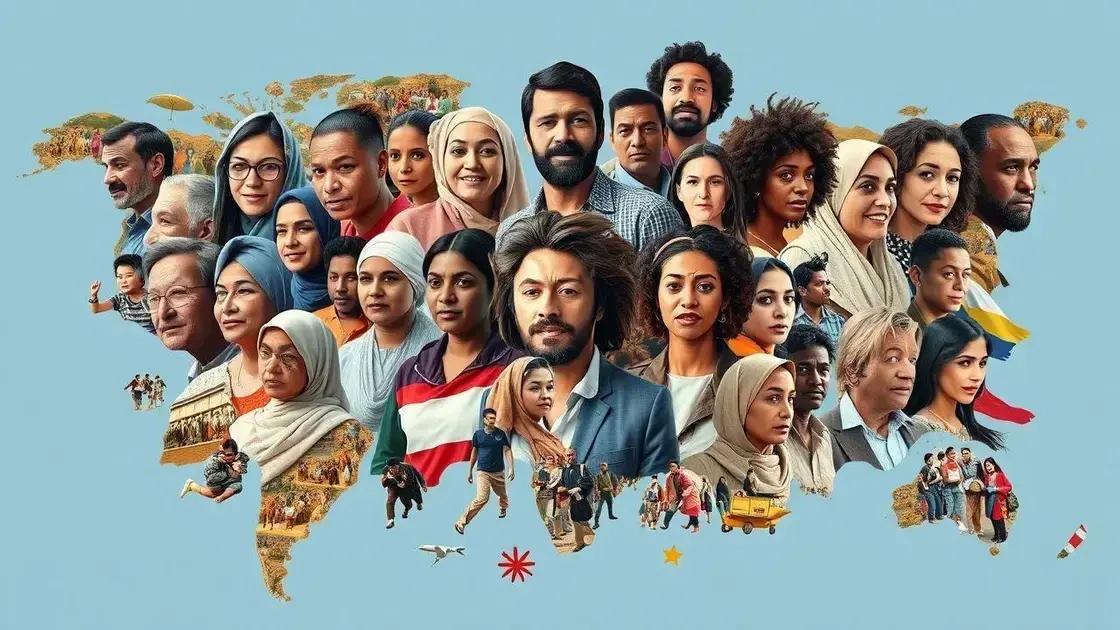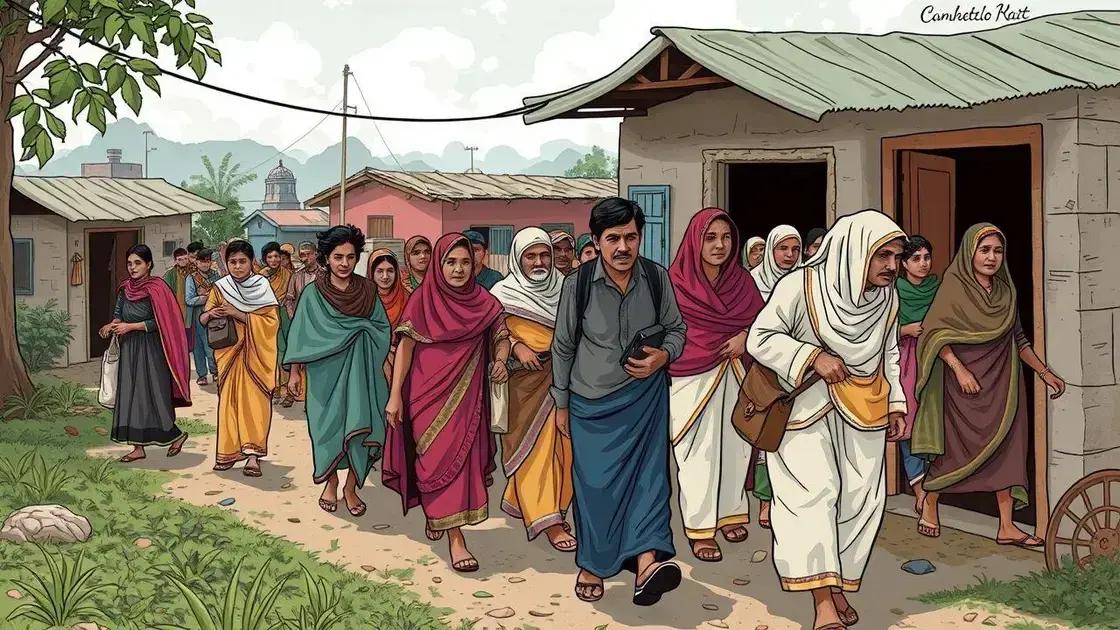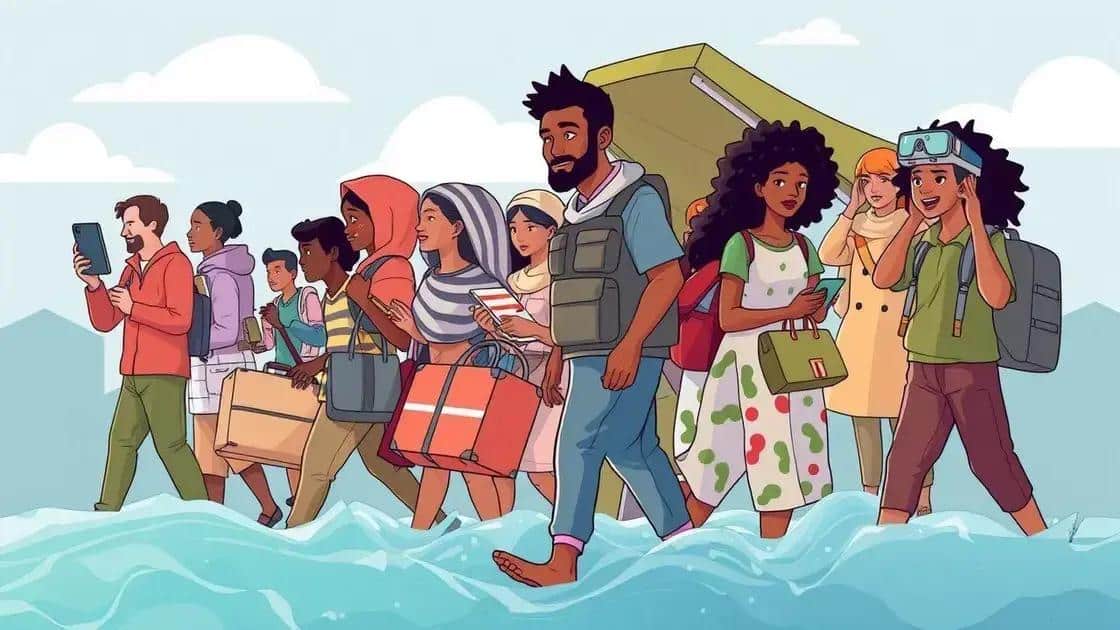International migration statistics updates you need to know

International migration statistics reveal that trends are driven by economic opportunities, political instability, and climate change, influencing where and why people choose to move globally.
International migration statistics updates provide valuable insights into global patterns that affect millions. Have you ever wondered how these trends shape economies and societies? Join us as we delve into the latest figures and their implications.
Understanding current trends in international migration
Understanding the current trends in international migration is essential for grasping the complexity of this global phenomenon. Migration patterns change over time, influenced by various factors such as economics, politics, and social conditions.
Key Trends
One of the notable trends is the increase in international migration due to economic opportunities. Many individuals are seeking better jobs in different countries that offer higher wages and improved living standards.
Factors Influencing Migration
Several factors play significant roles in this dynamic.
- Economic Conditions: Countries with stronger economies attract migrants.
- Political Instability: Conflicts and crises often force people to flee their homes.
- Social Networks: Migrants tend to move to areas where they have family or community support.
The social aspects of migration are equally crucial. Many migrants seek to reunite with family members who had previously moved abroad. Additionally, cultural exchanges enrich host countries.
Another emerging trend is the increase in irregular migration. Many individuals seek safer and legal pathways, but barriers sometimes push them into undocumented routes. Understanding these motivations helps us recognize the humanitarian challenges involved.
As we analyze these trends further, it becomes clear that the impacts of international migration are vast and varied, affecting not only individuals but also economies and societies as a whole. Policymakers need to be aware of these dynamics to create informed strategies that support both migrants and host communities.
Key factors driving migration statistics

Key factors driving migration statistics include a variety of economic, social, and political elements. Understanding these factors can help us grasp why people move and what influences their decisions.
Economic Opportunities
The search for better economic opportunities is one of the primary reasons people migrate. Individuals often leave their home countries to find jobs that offer better pay and benefits. This trend highlights the role of economic growth in attracting migrants.
Political Instability
Political instability can force many individuals to flee their countries. Conflicts, war, and repression lead to a surge in numbers as people seek safety and security in more stable regions.
- War and Conflict: Conflicts disrupt lives, pushing people to seek refuge elsewhere.
- Government Policies: Harsh immigration policies in some nations can increase illegal migration as people look for safer options.
- Rights and Freedoms: The lack of basic human rights can drive individuals to leave their homes in search of better living conditions.
Social networks also play a vital role in migration. Many people move to areas where they have family or community connections, making it easier for them to settle and find work. These networks provide not only support but also valuable information about job opportunities and housing.
Environmental factors are increasingly influential as well. Climate change, natural disasters, and resource depletion can displace communities and force migration. As the planet warms, more people are likely to move in search of livable conditions.
Each of these factors demonstrates that migration is often a complex decision influenced by multiple pressures. By examining these driving forces, we can better understand the patterns emerging in international migration statistics.
The impact of policy changes on migration
The impact of policy changes on migration is a crucial aspect in understanding how migration patterns evolve. Policies implemented by governments can either facilitate or hinder the movement of people across borders.
Changes in Immigration Laws
When countries adjust their immigration laws, the effects can be significant. Stricter laws may reduce the number of migrants entering a country, while more lenient policies can attract individuals seeking opportunities.
Border Control Measures
Enhanced border control measures often lead to increased migration challenges. These measures can create barriers, pushing migrants to seek unsafe routes. The intention may be to manage the flow of migrants, but often it results in heightened risks for those involved.
- Increased Deterrents: Stricter controls can deter legal migration.
- Smuggling Risks: More people may become victims of human trafficking as they try to cross borders illegally.
- Asylum Policies: Changes can affect the number of asylum seekers allowed in a country.
Additionally, shifts in social policies can influence migrant integration. Policies that promote inclusion can help migrants adapt and contribute positively to their new communities. However, exclusionary policies may lead to discrimination and social tension.
Having historical context helps interpret these changes. For example, many countries have revisited migration policies in response to global crises. As such, understanding the motivations behind these reforms is vital for assessing their long-term consequences.
The effects of policy changes extend beyond legal frameworks. They can shape economic conditions, social interactions, and the overall well-being of communities. Keeping an eye on these changes can help predict future migration trends and their implications.
Future projections for international migration patterns

Future projections for international migration patterns indicate that migration will continue to evolve due to various global factors. Understanding these trends is crucial for anticipating the needs of migrants and host countries.
Demographic Changes
One significant factor contributing to future migration patterns is demographic change. As populations grow in certain regions, particularly in developing countries, many individuals may seek opportunities abroad. This movement can create shifts in labor markets globally.
Climate Change Impact
Climate change is also expected to play a pivotal role in migration. As natural disasters become more frequent and severe, people will likely be forced to leave their homes. The displacement caused by rising sea levels and extreme weather events will create new migration challenges.
- Environmental Factors: Areas prone to drought or flooding may see increased out-migration.
- Resource Scarcity: Competition for water and food can lead to conflict and displacement.
- Climate Adaptation: Regions that develop better adaptation strategies may attract migrants.
Economic factors will continue to influence migration, with individuals seeking better employment opportunities. Developed countries may see an increase in skilled migrant workers as they require essential labor for economic growth. This trend can help bridge gaps in workforce shortages.
Technological advancements will also shape migration patterns. The rise of remote working options may lead to a new kind of migration where people choose to live in countries with a lower cost of living while remaining employed in higher-wage markets.
Finally, political developments, including changes in immigration policies, will directly impact migration flows. Countries that adopt favorable immigration laws may attract more migrants, while stricter policies could deter individuals from seeking opportunities abroad.
FAQ – Frequently Asked Questions about International Migration Patterns
What factors drive international migration?
Key factors include economic opportunities, political instability, climate change, and social networks that influence where people choose to move.
How does climate change affect migration?
Climate change leads to natural disasters and resource scarcity, prompting people to flee their homes in search of safer environments.
What role do immigration policies play in migration patterns?
Immigration policies can facilitate or hinder migration, impacting the number of people who can legally enter a country and the routes they take.
Why is it important to understand future migration trends?
Understanding future trends helps governments and organizations plan for the needs of migrants and create inclusive policies that benefit both migrants and host communities.





